Fault Tree Analysis: Causes and Recommendations for Preventing Catastrophic Flood Events in India
VerifiedAdded on 2023/01/12
|10
|2737
|33
AI Summary
This study focuses on the causes and recommendations for preventing catastrophic flood events in India using fault tree analysis. It discusses the description of the system and working environment, top catastrophic events and their effects, failures and causes of catastrophic events, a similar less catastrophic event, and effective recommendations to stop recurrence of top catastrophic events.
Contribute Materials
Your contribution can guide someone’s learning journey. Share your
documents today.

Fault tree analysis
Secure Best Marks with AI Grader
Need help grading? Try our AI Grader for instant feedback on your assignments.
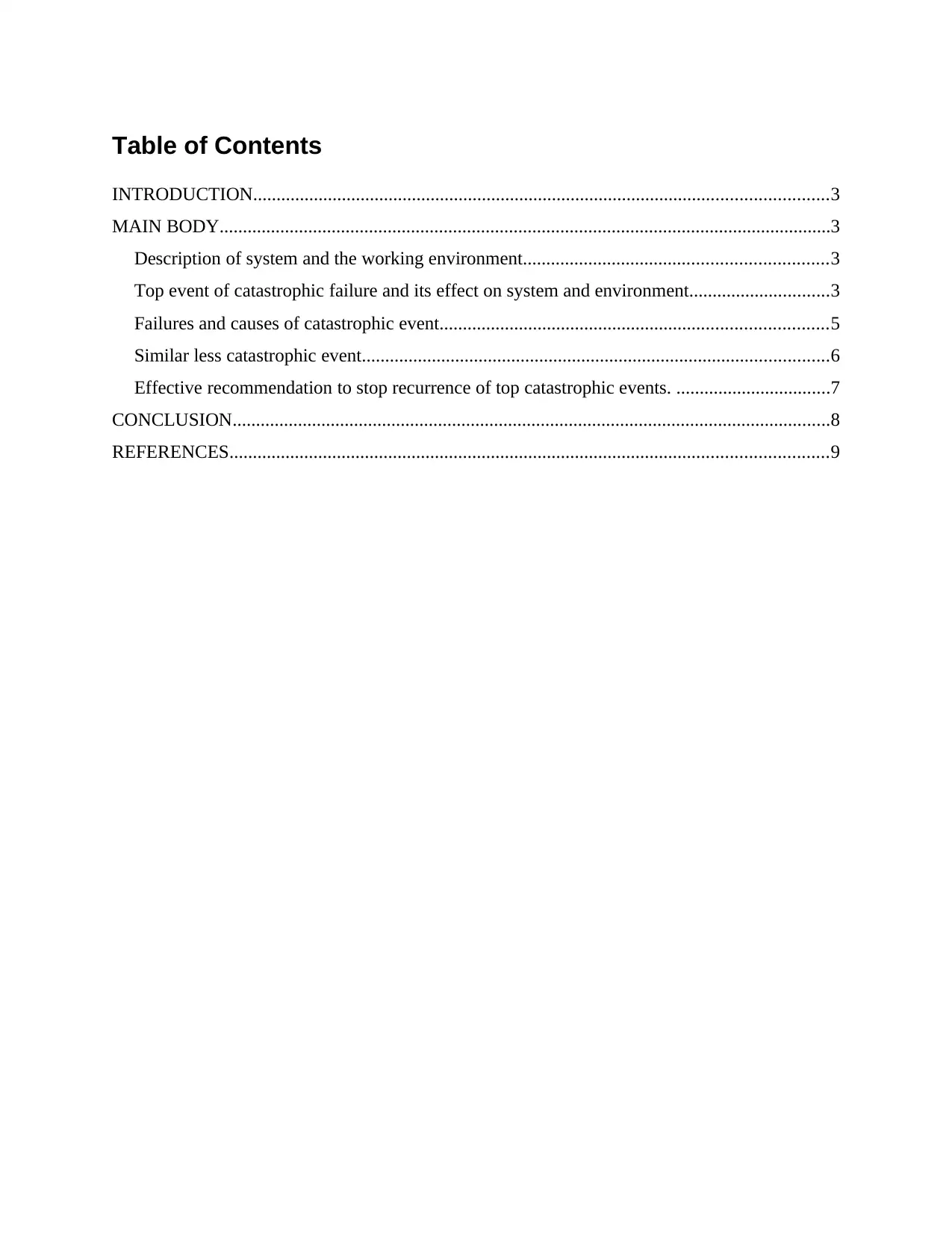
Table of Contents
INTRODUCTION...........................................................................................................................3
MAIN BODY...................................................................................................................................3
Description of system and the working environment.................................................................3
Top event of catastrophic failure and its effect on system and environment..............................3
Failures and causes of catastrophic event...................................................................................5
Similar less catastrophic event....................................................................................................6
Effective recommendation to stop recurrence of top catastrophic events. .................................7
CONCLUSION................................................................................................................................8
REFERENCES................................................................................................................................9
INTRODUCTION...........................................................................................................................3
MAIN BODY...................................................................................................................................3
Description of system and the working environment.................................................................3
Top event of catastrophic failure and its effect on system and environment..............................3
Failures and causes of catastrophic event...................................................................................5
Similar less catastrophic event....................................................................................................6
Effective recommendation to stop recurrence of top catastrophic events. .................................7
CONCLUSION................................................................................................................................8
REFERENCES................................................................................................................................9
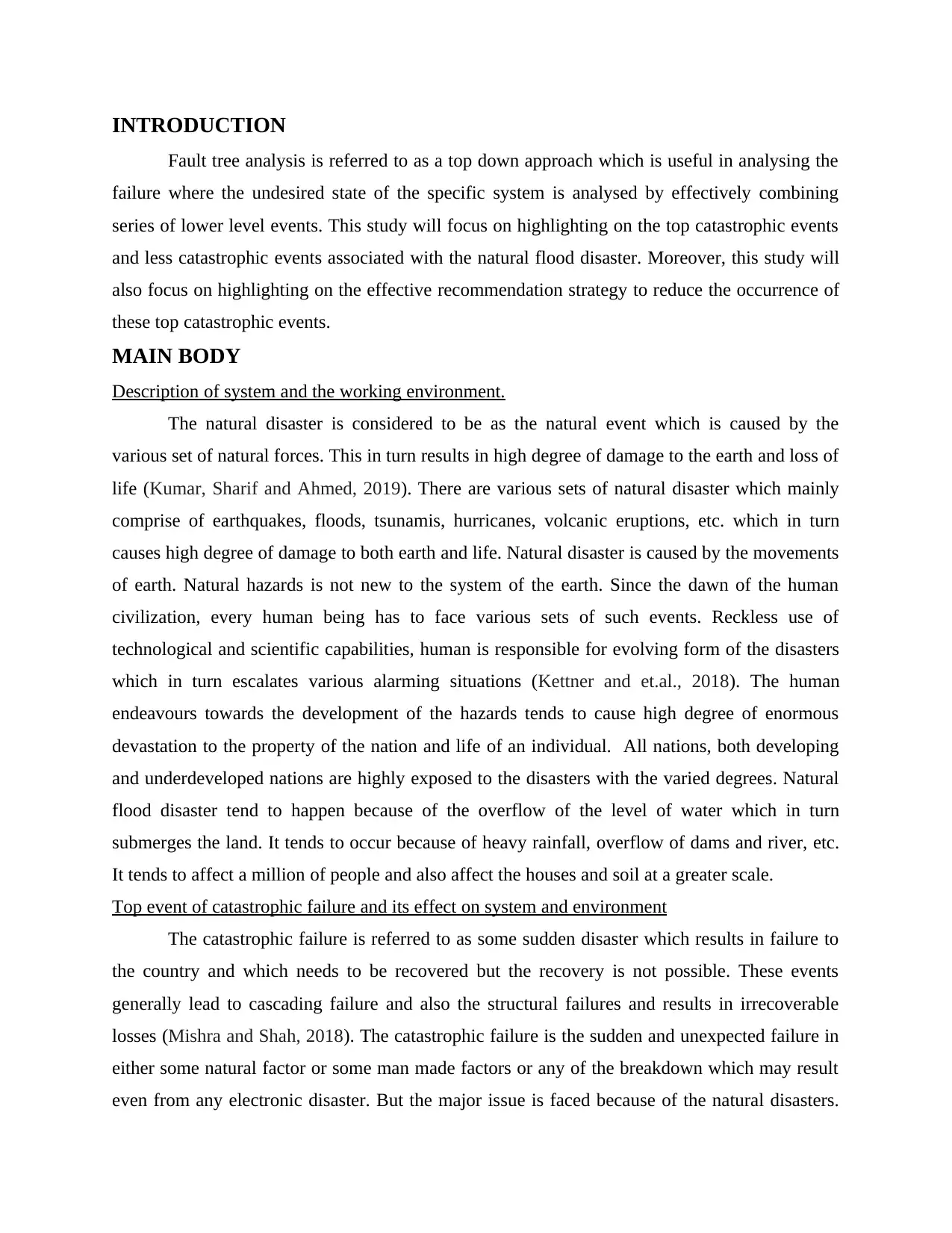
INTRODUCTION
Fault tree analysis is referred to as a top down approach which is useful in analysing the
failure where the undesired state of the specific system is analysed by effectively combining
series of lower level events. This study will focus on highlighting on the top catastrophic events
and less catastrophic events associated with the natural flood disaster. Moreover, this study will
also focus on highlighting on the effective recommendation strategy to reduce the occurrence of
these top catastrophic events.
MAIN BODY
Description of system and the working environment.
The natural disaster is considered to be as the natural event which is caused by the
various set of natural forces. This in turn results in high degree of damage to the earth and loss of
life (Kumar, Sharif and Ahmed, 2019). There are various sets of natural disaster which mainly
comprise of earthquakes, floods, tsunamis, hurricanes, volcanic eruptions, etc. which in turn
causes high degree of damage to both earth and life. Natural disaster is caused by the movements
of earth. Natural hazards is not new to the system of the earth. Since the dawn of the human
civilization, every human being has to face various sets of such events. Reckless use of
technological and scientific capabilities, human is responsible for evolving form of the disasters
which in turn escalates various alarming situations (Kettner and et.al., 2018). The human
endeavours towards the development of the hazards tends to cause high degree of enormous
devastation to the property of the nation and life of an individual. All nations, both developing
and underdeveloped nations are highly exposed to the disasters with the varied degrees. Natural
flood disaster tend to happen because of the overflow of the level of water which in turn
submerges the land. It tends to occur because of heavy rainfall, overflow of dams and river, etc.
It tends to affect a million of people and also affect the houses and soil at a greater scale.
Top event of catastrophic failure and its effect on system and environment
The catastrophic failure is referred to as some sudden disaster which results in failure to
the country and which needs to be recovered but the recovery is not possible. These events
generally lead to cascading failure and also the structural failures and results in irrecoverable
losses (Mishra and Shah, 2018). The catastrophic failure is the sudden and unexpected failure in
either some natural factor or some man made factors or any of the breakdown which may result
even from any electronic disaster. But the major issue is faced because of the natural disasters.
Fault tree analysis is referred to as a top down approach which is useful in analysing the
failure where the undesired state of the specific system is analysed by effectively combining
series of lower level events. This study will focus on highlighting on the top catastrophic events
and less catastrophic events associated with the natural flood disaster. Moreover, this study will
also focus on highlighting on the effective recommendation strategy to reduce the occurrence of
these top catastrophic events.
MAIN BODY
Description of system and the working environment.
The natural disaster is considered to be as the natural event which is caused by the
various set of natural forces. This in turn results in high degree of damage to the earth and loss of
life (Kumar, Sharif and Ahmed, 2019). There are various sets of natural disaster which mainly
comprise of earthquakes, floods, tsunamis, hurricanes, volcanic eruptions, etc. which in turn
causes high degree of damage to both earth and life. Natural disaster is caused by the movements
of earth. Natural hazards is not new to the system of the earth. Since the dawn of the human
civilization, every human being has to face various sets of such events. Reckless use of
technological and scientific capabilities, human is responsible for evolving form of the disasters
which in turn escalates various alarming situations (Kettner and et.al., 2018). The human
endeavours towards the development of the hazards tends to cause high degree of enormous
devastation to the property of the nation and life of an individual. All nations, both developing
and underdeveloped nations are highly exposed to the disasters with the varied degrees. Natural
flood disaster tend to happen because of the overflow of the level of water which in turn
submerges the land. It tends to occur because of heavy rainfall, overflow of dams and river, etc.
It tends to affect a million of people and also affect the houses and soil at a greater scale.
Top event of catastrophic failure and its effect on system and environment
The catastrophic failure is referred to as some sudden disaster which results in failure to
the country and which needs to be recovered but the recovery is not possible. These events
generally lead to cascading failure and also the structural failures and results in irrecoverable
losses (Mishra and Shah, 2018). The catastrophic failure is the sudden and unexpected failure in
either some natural factor or some man made factors or any of the breakdown which may result
even from any electronic disaster. But the major issue is faced because of the natural disasters.
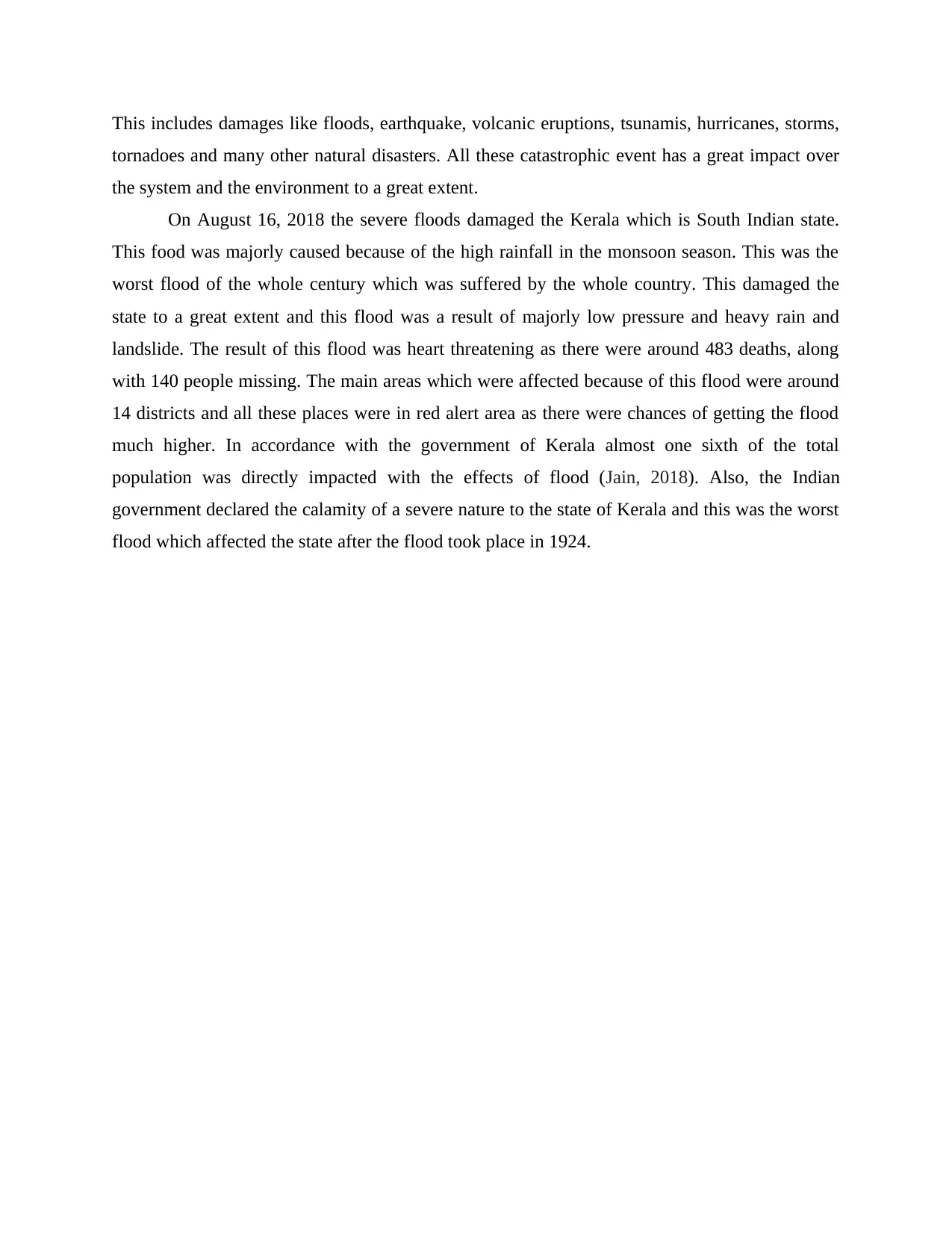
This includes damages like floods, earthquake, volcanic eruptions, tsunamis, hurricanes, storms,
tornadoes and many other natural disasters. All these catastrophic event has a great impact over
the system and the environment to a great extent.
On August 16, 2018 the severe floods damaged the Kerala which is South Indian state.
This food was majorly caused because of the high rainfall in the monsoon season. This was the
worst flood of the whole century which was suffered by the whole country. This damaged the
state to a great extent and this flood was a result of majorly low pressure and heavy rain and
landslide. The result of this flood was heart threatening as there were around 483 deaths, along
with 140 people missing. The main areas which were affected because of this flood were around
14 districts and all these places were in red alert area as there were chances of getting the flood
much higher. In accordance with the government of Kerala almost one sixth of the total
population was directly impacted with the effects of flood (Jain, 2018). Also, the Indian
government declared the calamity of a severe nature to the state of Kerala and this was the worst
flood which affected the state after the flood took place in 1924.
tornadoes and many other natural disasters. All these catastrophic event has a great impact over
the system and the environment to a great extent.
On August 16, 2018 the severe floods damaged the Kerala which is South Indian state.
This food was majorly caused because of the high rainfall in the monsoon season. This was the
worst flood of the whole century which was suffered by the whole country. This damaged the
state to a great extent and this flood was a result of majorly low pressure and heavy rain and
landslide. The result of this flood was heart threatening as there were around 483 deaths, along
with 140 people missing. The main areas which were affected because of this flood were around
14 districts and all these places were in red alert area as there were chances of getting the flood
much higher. In accordance with the government of Kerala almost one sixth of the total
population was directly impacted with the effects of flood (Jain, 2018). Also, the Indian
government declared the calamity of a severe nature to the state of Kerala and this was the worst
flood which affected the state after the flood took place in 1924.
Secure Best Marks with AI Grader
Need help grading? Try our AI Grader for instant feedback on your assignments.
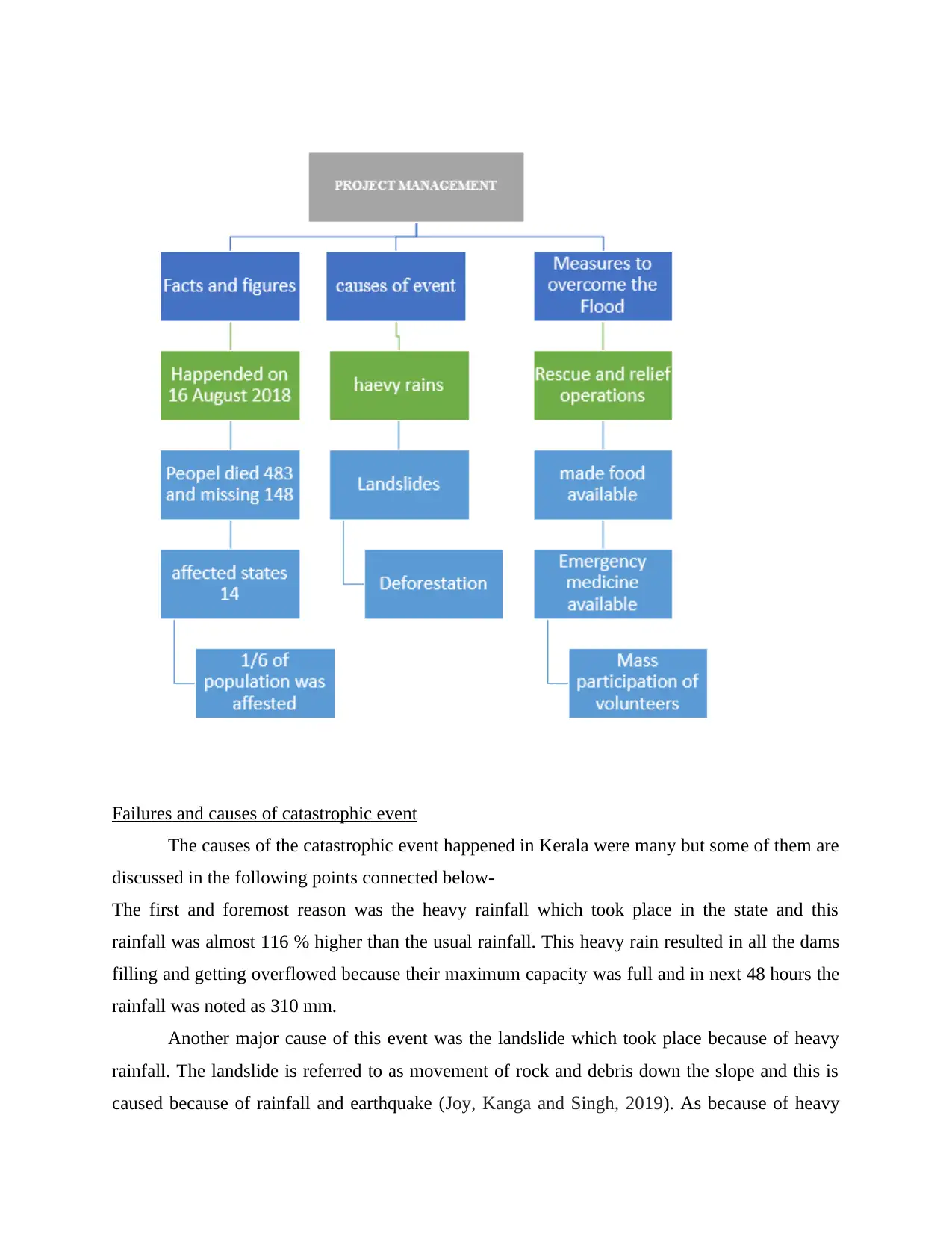
Failures and causes of catastrophic event
The causes of the catastrophic event happened in Kerala were many but some of them are
discussed in the following points connected below-
The first and foremost reason was the heavy rainfall which took place in the state and this
rainfall was almost 116 % higher than the usual rainfall. This heavy rain resulted in all the dams
filling and getting overflowed because their maximum capacity was full and in next 48 hours the
rainfall was noted as 310 mm.
Another major cause of this event was the landslide which took place because of heavy
rainfall. The landslide is referred to as movement of rock and debris down the slope and this is
caused because of rainfall and earthquake (Joy, Kanga and Singh, 2019). As because of heavy
The causes of the catastrophic event happened in Kerala were many but some of them are
discussed in the following points connected below-
The first and foremost reason was the heavy rainfall which took place in the state and this
rainfall was almost 116 % higher than the usual rainfall. This heavy rain resulted in all the dams
filling and getting overflowed because their maximum capacity was full and in next 48 hours the
rainfall was noted as 310 mm.
Another major cause of this event was the landslide which took place because of heavy
rainfall. The landslide is referred to as movement of rock and debris down the slope and this is
caused because of rainfall and earthquake (Joy, Kanga and Singh, 2019). As because of heavy
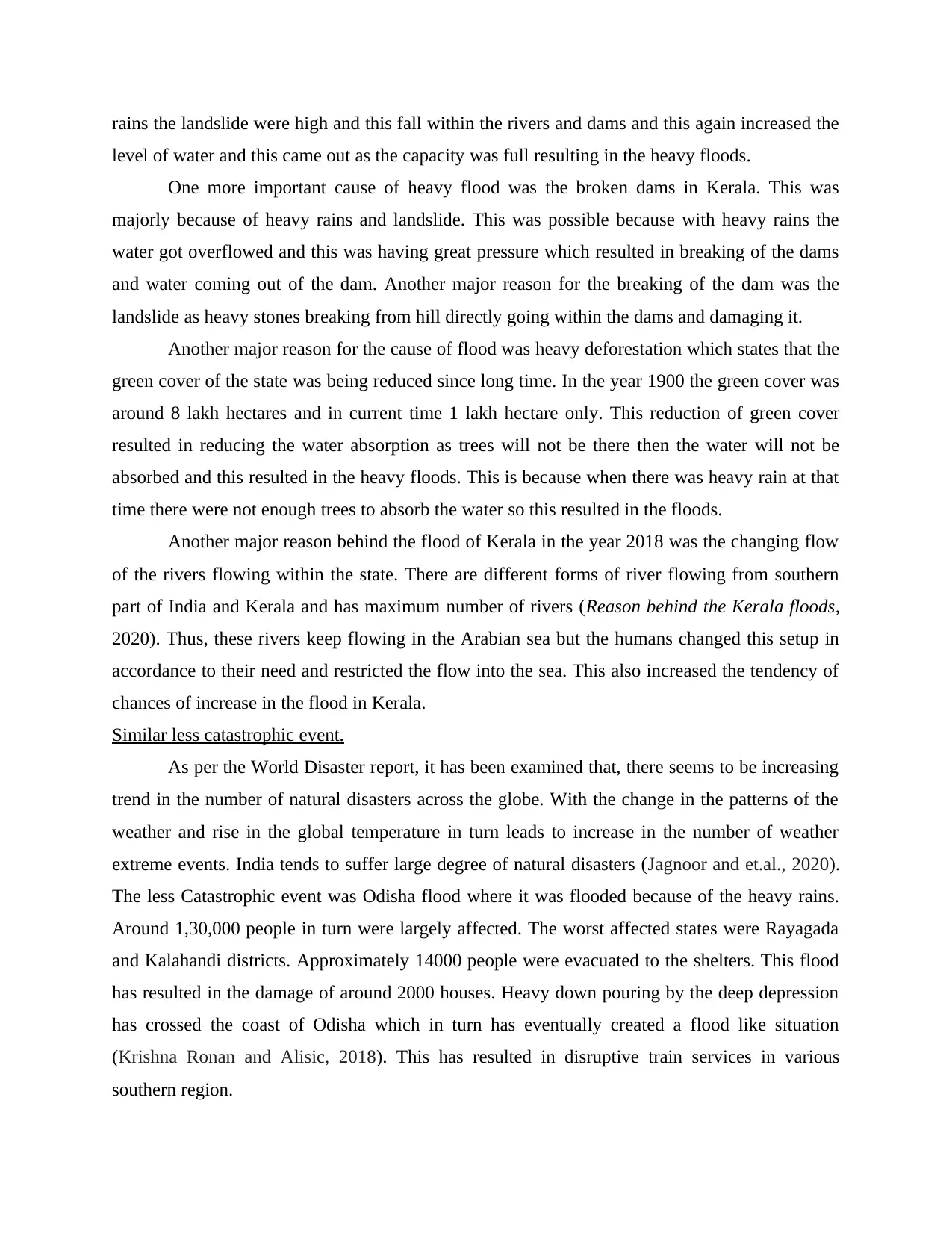
rains the landslide were high and this fall within the rivers and dams and this again increased the
level of water and this came out as the capacity was full resulting in the heavy floods.
One more important cause of heavy flood was the broken dams in Kerala. This was
majorly because of heavy rains and landslide. This was possible because with heavy rains the
water got overflowed and this was having great pressure which resulted in breaking of the dams
and water coming out of the dam. Another major reason for the breaking of the dam was the
landslide as heavy stones breaking from hill directly going within the dams and damaging it.
Another major reason for the cause of flood was heavy deforestation which states that the
green cover of the state was being reduced since long time. In the year 1900 the green cover was
around 8 lakh hectares and in current time 1 lakh hectare only. This reduction of green cover
resulted in reducing the water absorption as trees will not be there then the water will not be
absorbed and this resulted in the heavy floods. This is because when there was heavy rain at that
time there were not enough trees to absorb the water so this resulted in the floods.
Another major reason behind the flood of Kerala in the year 2018 was the changing flow
of the rivers flowing within the state. There are different forms of river flowing from southern
part of India and Kerala and has maximum number of rivers (Reason behind the Kerala floods,
2020). Thus, these rivers keep flowing in the Arabian sea but the humans changed this setup in
accordance to their need and restricted the flow into the sea. This also increased the tendency of
chances of increase in the flood in Kerala.
Similar less catastrophic event.
As per the World Disaster report, it has been examined that, there seems to be increasing
trend in the number of natural disasters across the globe. With the change in the patterns of the
weather and rise in the global temperature in turn leads to increase in the number of weather
extreme events. India tends to suffer large degree of natural disasters (Jagnoor and et.al., 2020).
The less Catastrophic event was Odisha flood where it was flooded because of the heavy rains.
Around 1,30,000 people in turn were largely affected. The worst affected states were Rayagada
and Kalahandi districts. Approximately 14000 people were evacuated to the shelters. This flood
has resulted in the damage of around 2000 houses. Heavy down pouring by the deep depression
has crossed the coast of Odisha which in turn has eventually created a flood like situation
(Krishna Ronan and Alisic, 2018). This has resulted in disruptive train services in various
southern region.
level of water and this came out as the capacity was full resulting in the heavy floods.
One more important cause of heavy flood was the broken dams in Kerala. This was
majorly because of heavy rains and landslide. This was possible because with heavy rains the
water got overflowed and this was having great pressure which resulted in breaking of the dams
and water coming out of the dam. Another major reason for the breaking of the dam was the
landslide as heavy stones breaking from hill directly going within the dams and damaging it.
Another major reason for the cause of flood was heavy deforestation which states that the
green cover of the state was being reduced since long time. In the year 1900 the green cover was
around 8 lakh hectares and in current time 1 lakh hectare only. This reduction of green cover
resulted in reducing the water absorption as trees will not be there then the water will not be
absorbed and this resulted in the heavy floods. This is because when there was heavy rain at that
time there were not enough trees to absorb the water so this resulted in the floods.
Another major reason behind the flood of Kerala in the year 2018 was the changing flow
of the rivers flowing within the state. There are different forms of river flowing from southern
part of India and Kerala and has maximum number of rivers (Reason behind the Kerala floods,
2020). Thus, these rivers keep flowing in the Arabian sea but the humans changed this setup in
accordance to their need and restricted the flow into the sea. This also increased the tendency of
chances of increase in the flood in Kerala.
Similar less catastrophic event.
As per the World Disaster report, it has been examined that, there seems to be increasing
trend in the number of natural disasters across the globe. With the change in the patterns of the
weather and rise in the global temperature in turn leads to increase in the number of weather
extreme events. India tends to suffer large degree of natural disasters (Jagnoor and et.al., 2020).
The less Catastrophic event was Odisha flood where it was flooded because of the heavy rains.
Around 1,30,000 people in turn were largely affected. The worst affected states were Rayagada
and Kalahandi districts. Approximately 14000 people were evacuated to the shelters. This flood
has resulted in the damage of around 2000 houses. Heavy down pouring by the deep depression
has crossed the coast of Odisha which in turn has eventually created a flood like situation
(Krishna Ronan and Alisic, 2018). This has resulted in disruptive train services in various
southern region.
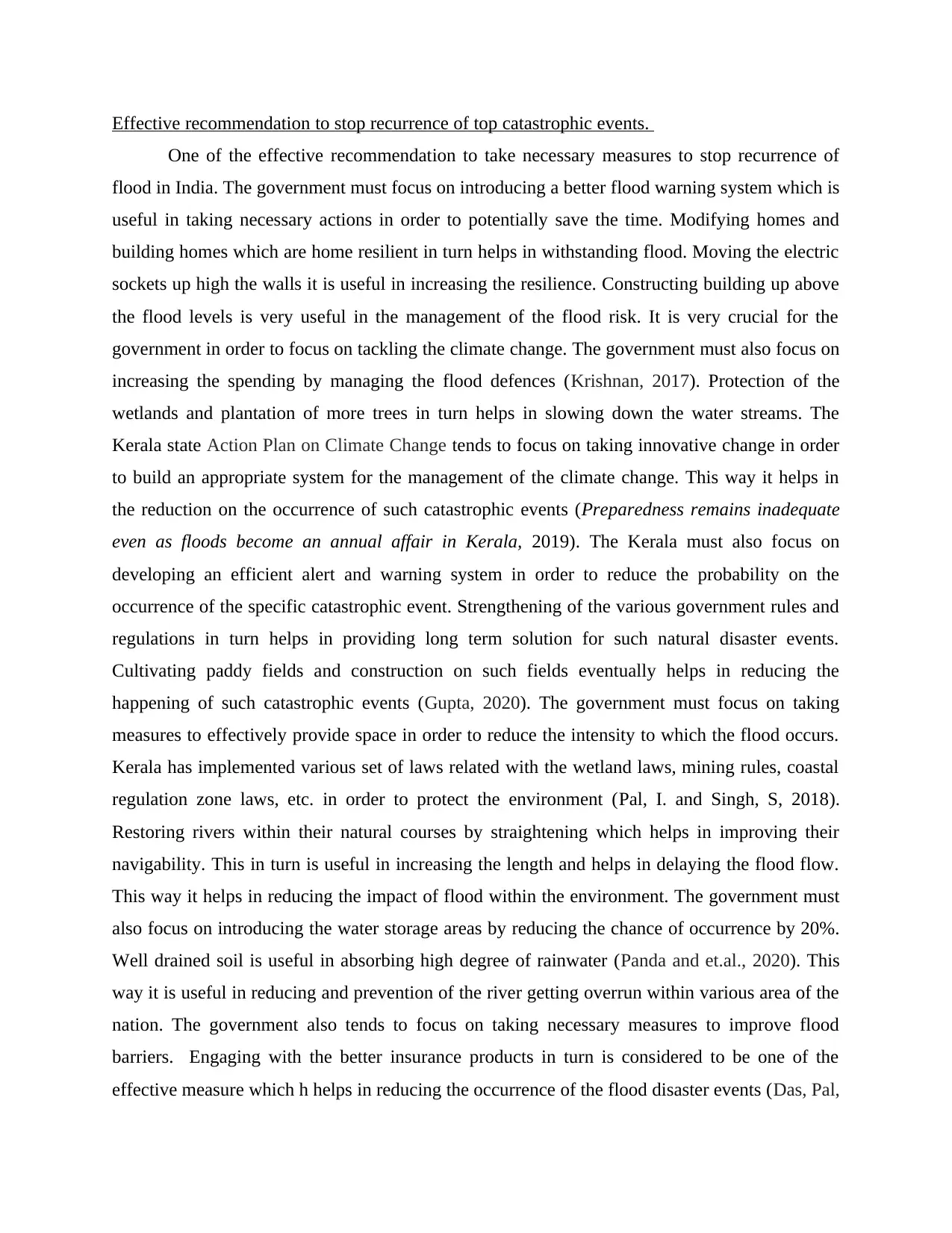
Effective recommendation to stop recurrence of top catastrophic events.
One of the effective recommendation to take necessary measures to stop recurrence of
flood in India. The government must focus on introducing a better flood warning system which is
useful in taking necessary actions in order to potentially save the time. Modifying homes and
building homes which are home resilient in turn helps in withstanding flood. Moving the electric
sockets up high the walls it is useful in increasing the resilience. Constructing building up above
the flood levels is very useful in the management of the flood risk. It is very crucial for the
government in order to focus on tackling the climate change. The government must also focus on
increasing the spending by managing the flood defences (Krishnan, 2017). Protection of the
wetlands and plantation of more trees in turn helps in slowing down the water streams. The
Kerala state Action Plan on Climate Change tends to focus on taking innovative change in order
to build an appropriate system for the management of the climate change. This way it helps in
the reduction on the occurrence of such catastrophic events (Preparedness remains inadequate
even as floods become an annual affair in Kerala, 2019). The Kerala must also focus on
developing an efficient alert and warning system in order to reduce the probability on the
occurrence of the specific catastrophic event. Strengthening of the various government rules and
regulations in turn helps in providing long term solution for such natural disaster events.
Cultivating paddy fields and construction on such fields eventually helps in reducing the
happening of such catastrophic events (Gupta, 2020). The government must focus on taking
measures to effectively provide space in order to reduce the intensity to which the flood occurs.
Kerala has implemented various set of laws related with the wetland laws, mining rules, coastal
regulation zone laws, etc. in order to protect the environment (Pal, I. and Singh, S, 2018).
Restoring rivers within their natural courses by straightening which helps in improving their
navigability. This in turn is useful in increasing the length and helps in delaying the flood flow.
This way it helps in reducing the impact of flood within the environment. The government must
also focus on introducing the water storage areas by reducing the chance of occurrence by 20%.
Well drained soil is useful in absorbing high degree of rainwater (Panda and et.al., 2020). This
way it is useful in reducing and prevention of the river getting overrun within various area of the
nation. The government also tends to focus on taking necessary measures to improve flood
barriers. Engaging with the better insurance products in turn is considered to be one of the
effective measure which h helps in reducing the occurrence of the flood disaster events (Das, Pal,
One of the effective recommendation to take necessary measures to stop recurrence of
flood in India. The government must focus on introducing a better flood warning system which is
useful in taking necessary actions in order to potentially save the time. Modifying homes and
building homes which are home resilient in turn helps in withstanding flood. Moving the electric
sockets up high the walls it is useful in increasing the resilience. Constructing building up above
the flood levels is very useful in the management of the flood risk. It is very crucial for the
government in order to focus on tackling the climate change. The government must also focus on
increasing the spending by managing the flood defences (Krishnan, 2017). Protection of the
wetlands and plantation of more trees in turn helps in slowing down the water streams. The
Kerala state Action Plan on Climate Change tends to focus on taking innovative change in order
to build an appropriate system for the management of the climate change. This way it helps in
the reduction on the occurrence of such catastrophic events (Preparedness remains inadequate
even as floods become an annual affair in Kerala, 2019). The Kerala must also focus on
developing an efficient alert and warning system in order to reduce the probability on the
occurrence of the specific catastrophic event. Strengthening of the various government rules and
regulations in turn helps in providing long term solution for such natural disaster events.
Cultivating paddy fields and construction on such fields eventually helps in reducing the
happening of such catastrophic events (Gupta, 2020). The government must focus on taking
measures to effectively provide space in order to reduce the intensity to which the flood occurs.
Kerala has implemented various set of laws related with the wetland laws, mining rules, coastal
regulation zone laws, etc. in order to protect the environment (Pal, I. and Singh, S, 2018).
Restoring rivers within their natural courses by straightening which helps in improving their
navigability. This in turn is useful in increasing the length and helps in delaying the flood flow.
This way it helps in reducing the impact of flood within the environment. The government must
also focus on introducing the water storage areas by reducing the chance of occurrence by 20%.
Well drained soil is useful in absorbing high degree of rainwater (Panda and et.al., 2020). This
way it is useful in reducing and prevention of the river getting overrun within various area of the
nation. The government also tends to focus on taking necessary measures to improve flood
barriers. Engaging with the better insurance products in turn is considered to be one of the
effective measure which h helps in reducing the occurrence of the flood disaster events (Das, Pal,
Paraphrase This Document
Need a fresh take? Get an instant paraphrase of this document with our AI Paraphraser
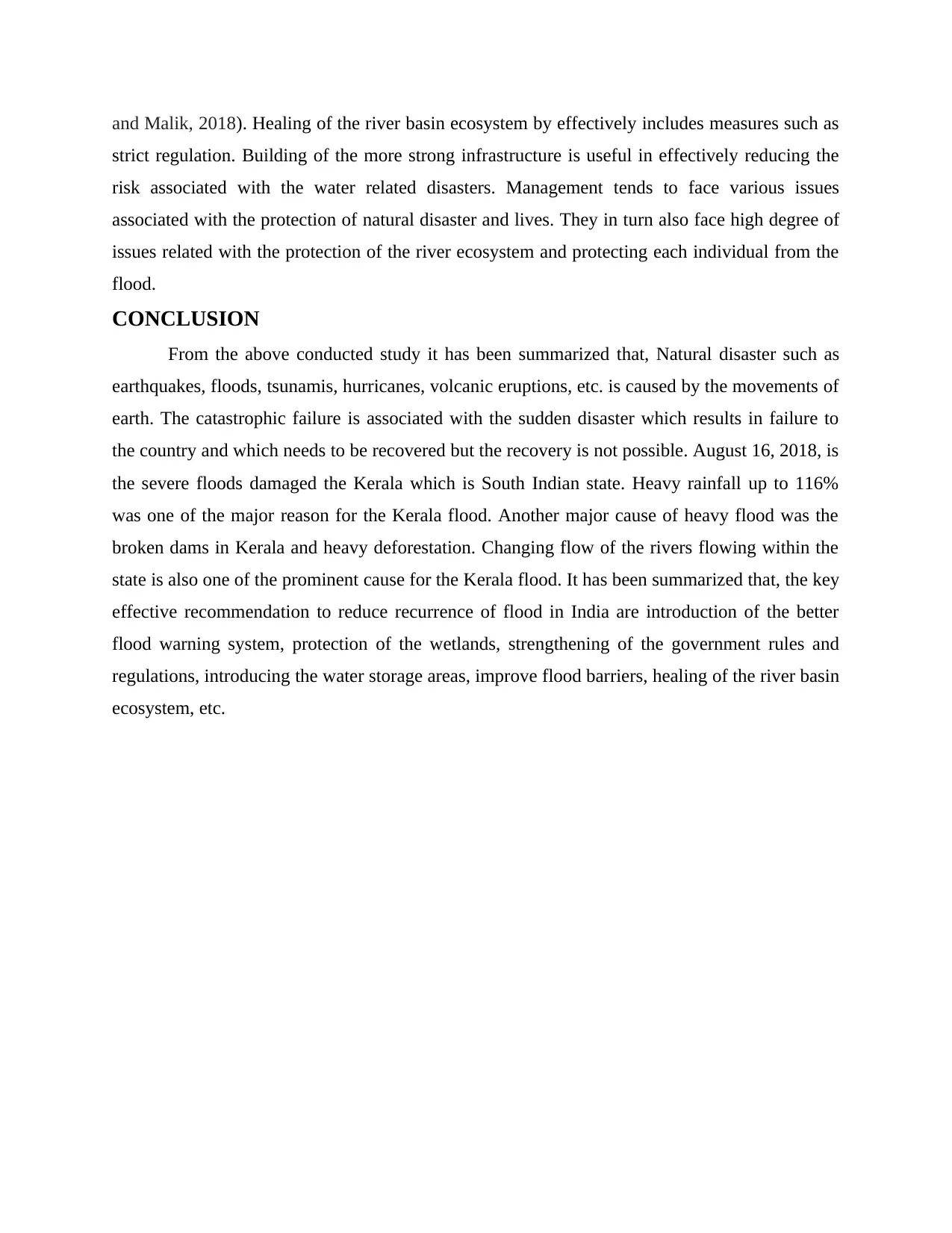
and Malik, 2018). Healing of the river basin ecosystem by effectively includes measures such as
strict regulation. Building of the more strong infrastructure is useful in effectively reducing the
risk associated with the water related disasters. Management tends to face various issues
associated with the protection of natural disaster and lives. They in turn also face high degree of
issues related with the protection of the river ecosystem and protecting each individual from the
flood.
CONCLUSION
From the above conducted study it has been summarized that, Natural disaster such as
earthquakes, floods, tsunamis, hurricanes, volcanic eruptions, etc. is caused by the movements of
earth. The catastrophic failure is associated with the sudden disaster which results in failure to
the country and which needs to be recovered but the recovery is not possible. August 16, 2018, is
the severe floods damaged the Kerala which is South Indian state. Heavy rainfall up to 116%
was one of the major reason for the Kerala flood. Another major cause of heavy flood was the
broken dams in Kerala and heavy deforestation. Changing flow of the rivers flowing within the
state is also one of the prominent cause for the Kerala flood. It has been summarized that, the key
effective recommendation to reduce recurrence of flood in India are introduction of the better
flood warning system, protection of the wetlands, strengthening of the government rules and
regulations, introducing the water storage areas, improve flood barriers, healing of the river basin
ecosystem, etc.
strict regulation. Building of the more strong infrastructure is useful in effectively reducing the
risk associated with the water related disasters. Management tends to face various issues
associated with the protection of natural disaster and lives. They in turn also face high degree of
issues related with the protection of the river ecosystem and protecting each individual from the
flood.
CONCLUSION
From the above conducted study it has been summarized that, Natural disaster such as
earthquakes, floods, tsunamis, hurricanes, volcanic eruptions, etc. is caused by the movements of
earth. The catastrophic failure is associated with the sudden disaster which results in failure to
the country and which needs to be recovered but the recovery is not possible. August 16, 2018, is
the severe floods damaged the Kerala which is South Indian state. Heavy rainfall up to 116%
was one of the major reason for the Kerala flood. Another major cause of heavy flood was the
broken dams in Kerala and heavy deforestation. Changing flow of the rivers flowing within the
state is also one of the prominent cause for the Kerala flood. It has been summarized that, the key
effective recommendation to reduce recurrence of flood in India are introduction of the better
flood warning system, protection of the wetlands, strengthening of the government rules and
regulations, introducing the water storage areas, improve flood barriers, healing of the river basin
ecosystem, etc.
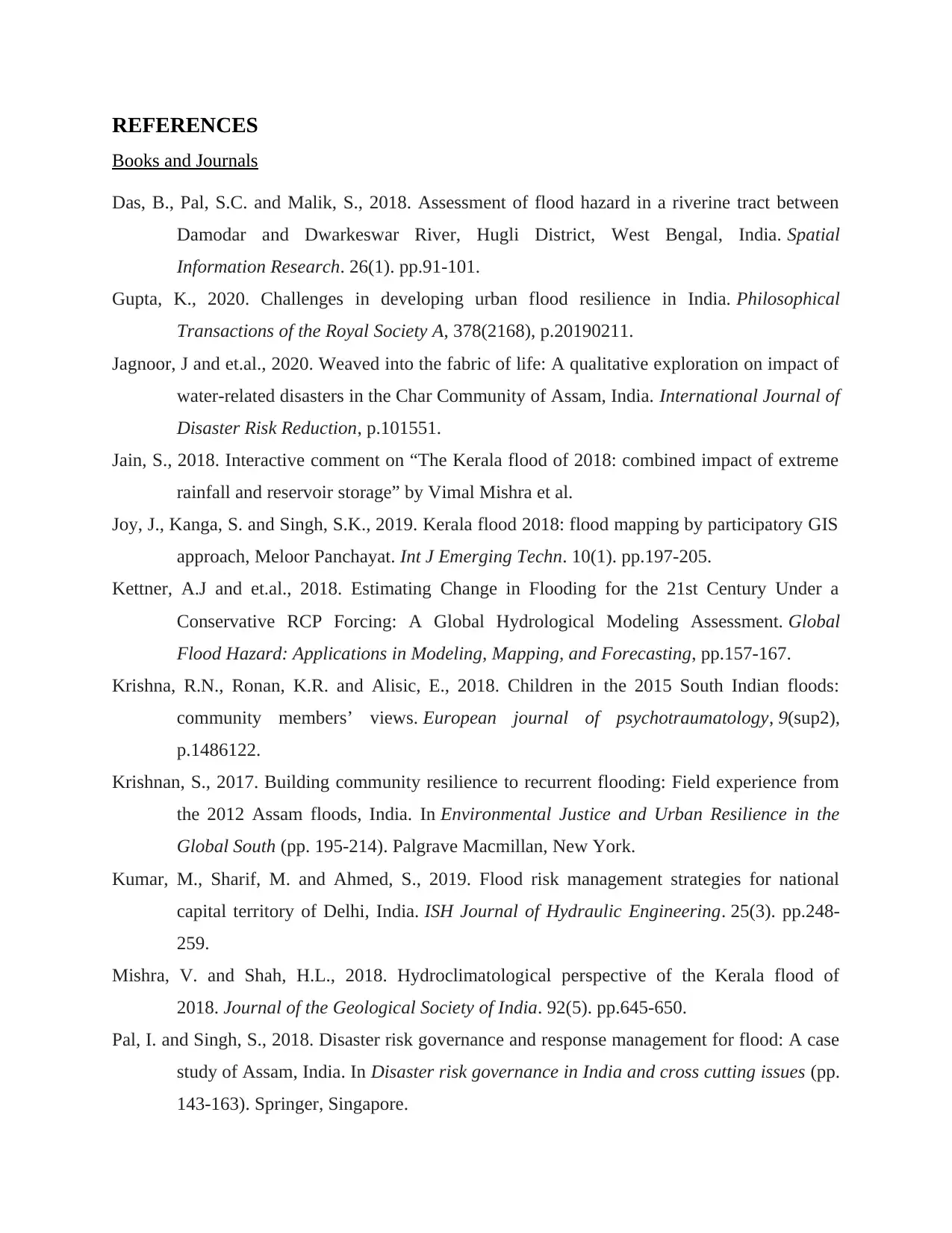
REFERENCES
Books and Journals
Das, B., Pal, S.C. and Malik, S., 2018. Assessment of flood hazard in a riverine tract between
Damodar and Dwarkeswar River, Hugli District, West Bengal, India. Spatial
Information Research. 26(1). pp.91-101.
Gupta, K., 2020. Challenges in developing urban flood resilience in India. Philosophical
Transactions of the Royal Society A, 378(2168), p.20190211.
Jagnoor, J and et.al., 2020. Weaved into the fabric of life: A qualitative exploration on impact of
water-related disasters in the Char Community of Assam, India. International Journal of
Disaster Risk Reduction, p.101551.
Jain, S., 2018. Interactive comment on “The Kerala flood of 2018: combined impact of extreme
rainfall and reservoir storage” by Vimal Mishra et al.
Joy, J., Kanga, S. and Singh, S.K., 2019. Kerala flood 2018: flood mapping by participatory GIS
approach, Meloor Panchayat. Int J Emerging Techn. 10(1). pp.197-205.
Kettner, A.J and et.al., 2018. Estimating Change in Flooding for the 21st Century Under a
Conservative RCP Forcing: A Global Hydrological Modeling Assessment. Global
Flood Hazard: Applications in Modeling, Mapping, and Forecasting, pp.157-167.
Krishna, R.N., Ronan, K.R. and Alisic, E., 2018. Children in the 2015 South Indian floods:
community members’ views. European journal of psychotraumatology, 9(sup2),
p.1486122.
Krishnan, S., 2017. Building community resilience to recurrent flooding: Field experience from
the 2012 Assam floods, India. In Environmental Justice and Urban Resilience in the
Global South (pp. 195-214). Palgrave Macmillan, New York.
Kumar, M., Sharif, M. and Ahmed, S., 2019. Flood risk management strategies for national
capital territory of Delhi, India. ISH Journal of Hydraulic Engineering. 25(3). pp.248-
259.
Mishra, V. and Shah, H.L., 2018. Hydroclimatological perspective of the Kerala flood of
2018. Journal of the Geological Society of India. 92(5). pp.645-650.
Pal, I. and Singh, S., 2018. Disaster risk governance and response management for flood: A case
study of Assam, India. In Disaster risk governance in India and cross cutting issues (pp.
143-163). Springer, Singapore.
Books and Journals
Das, B., Pal, S.C. and Malik, S., 2018. Assessment of flood hazard in a riverine tract between
Damodar and Dwarkeswar River, Hugli District, West Bengal, India. Spatial
Information Research. 26(1). pp.91-101.
Gupta, K., 2020. Challenges in developing urban flood resilience in India. Philosophical
Transactions of the Royal Society A, 378(2168), p.20190211.
Jagnoor, J and et.al., 2020. Weaved into the fabric of life: A qualitative exploration on impact of
water-related disasters in the Char Community of Assam, India. International Journal of
Disaster Risk Reduction, p.101551.
Jain, S., 2018. Interactive comment on “The Kerala flood of 2018: combined impact of extreme
rainfall and reservoir storage” by Vimal Mishra et al.
Joy, J., Kanga, S. and Singh, S.K., 2019. Kerala flood 2018: flood mapping by participatory GIS
approach, Meloor Panchayat. Int J Emerging Techn. 10(1). pp.197-205.
Kettner, A.J and et.al., 2018. Estimating Change in Flooding for the 21st Century Under a
Conservative RCP Forcing: A Global Hydrological Modeling Assessment. Global
Flood Hazard: Applications in Modeling, Mapping, and Forecasting, pp.157-167.
Krishna, R.N., Ronan, K.R. and Alisic, E., 2018. Children in the 2015 South Indian floods:
community members’ views. European journal of psychotraumatology, 9(sup2),
p.1486122.
Krishnan, S., 2017. Building community resilience to recurrent flooding: Field experience from
the 2012 Assam floods, India. In Environmental Justice and Urban Resilience in the
Global South (pp. 195-214). Palgrave Macmillan, New York.
Kumar, M., Sharif, M. and Ahmed, S., 2019. Flood risk management strategies for national
capital territory of Delhi, India. ISH Journal of Hydraulic Engineering. 25(3). pp.248-
259.
Mishra, V. and Shah, H.L., 2018. Hydroclimatological perspective of the Kerala flood of
2018. Journal of the Geological Society of India. 92(5). pp.645-650.
Pal, I. and Singh, S., 2018. Disaster risk governance and response management for flood: A case
study of Assam, India. In Disaster risk governance in India and cross cutting issues (pp.
143-163). Springer, Singapore.
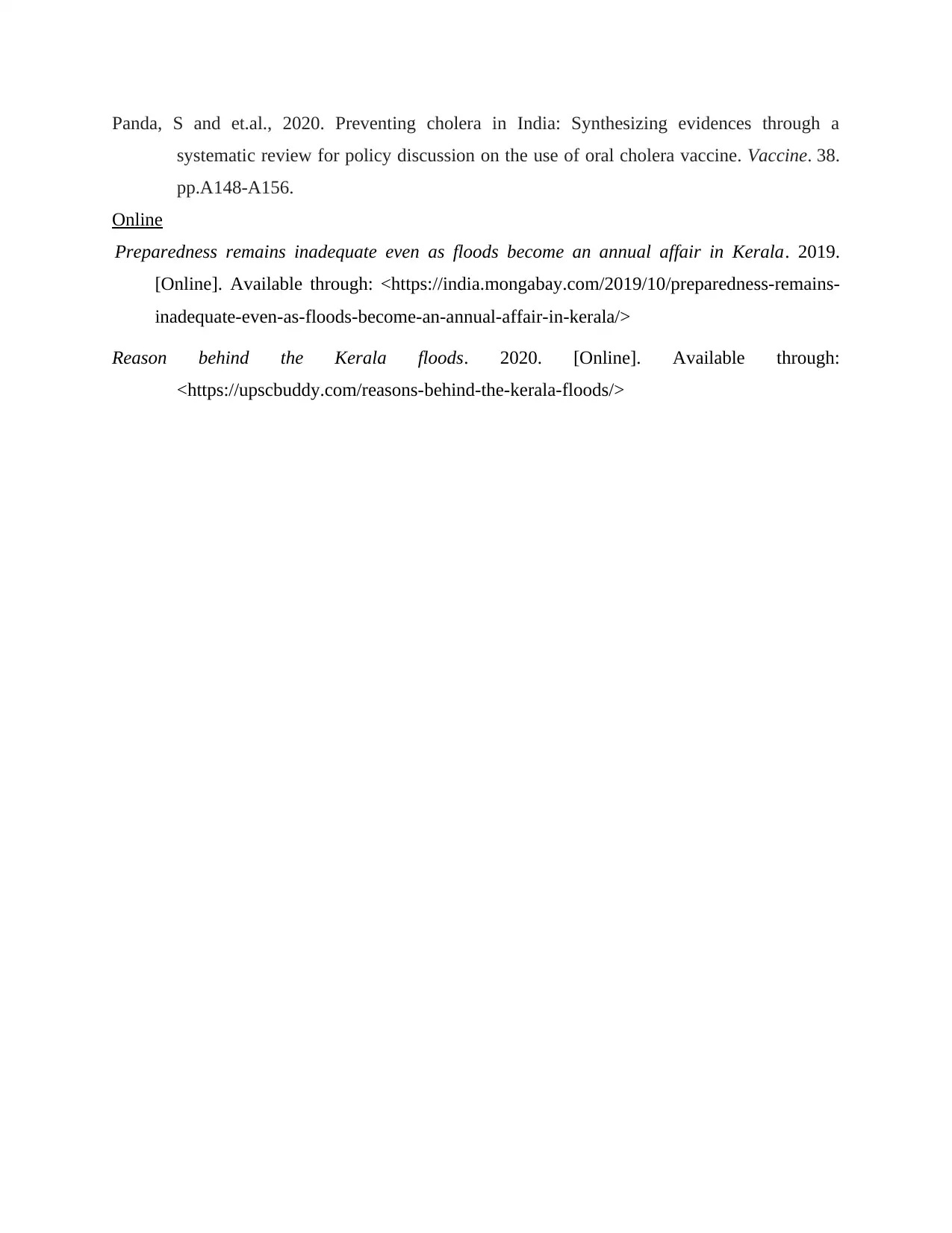
Panda, S and et.al., 2020. Preventing cholera in India: Synthesizing evidences through a
systematic review for policy discussion on the use of oral cholera vaccine. Vaccine. 38.
pp.A148-A156.
Online
Preparedness remains inadequate even as floods become an annual affair in Kerala. 2019.
[Online]. Available through: <https://india.mongabay.com/2019/10/preparedness-remains-
inadequate-even-as-floods-become-an-annual-affair-in-kerala/>
Reason behind the Kerala floods. 2020. [Online]. Available through:
<https://upscbuddy.com/reasons-behind-the-kerala-floods/>
systematic review for policy discussion on the use of oral cholera vaccine. Vaccine. 38.
pp.A148-A156.
Online
Preparedness remains inadequate even as floods become an annual affair in Kerala. 2019.
[Online]. Available through: <https://india.mongabay.com/2019/10/preparedness-remains-
inadequate-even-as-floods-become-an-annual-affair-in-kerala/>
Reason behind the Kerala floods. 2020. [Online]. Available through:
<https://upscbuddy.com/reasons-behind-the-kerala-floods/>
1 out of 10
Related Documents
Your All-in-One AI-Powered Toolkit for Academic Success.
+13062052269
info@desklib.com
Available 24*7 on WhatsApp / Email
![[object Object]](/_next/static/media/star-bottom.7253800d.svg)
Unlock your academic potential
© 2024 | Zucol Services PVT LTD | All rights reserved.





